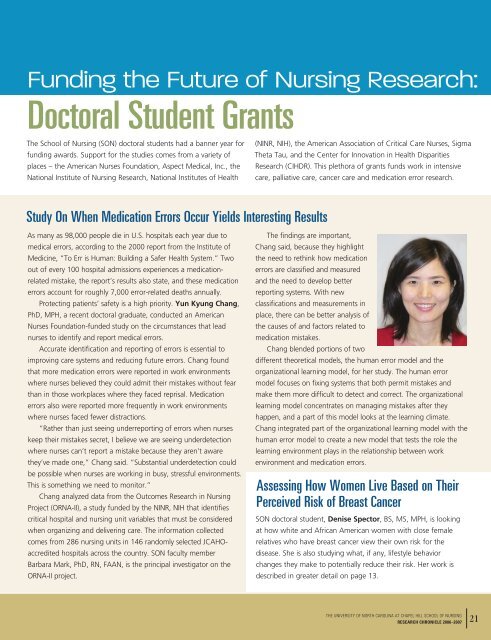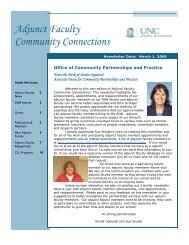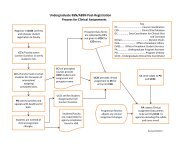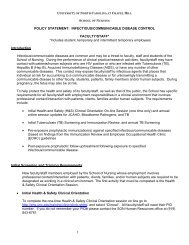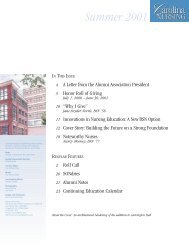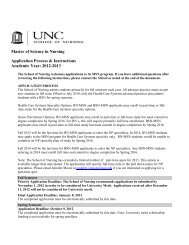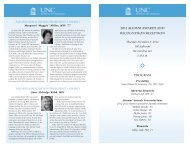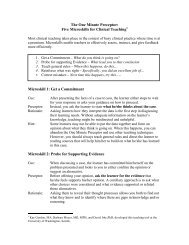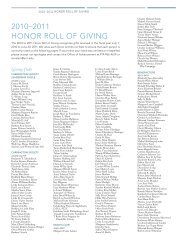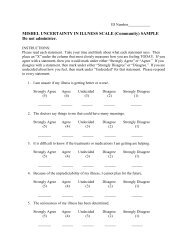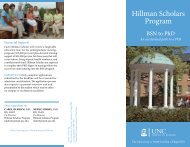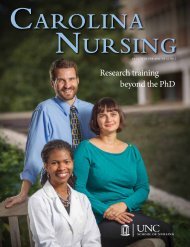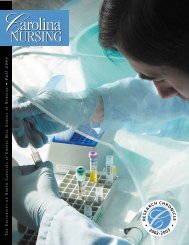Research Chronicle, 2006 - School of Nursing - University of North ...
Research Chronicle, 2006 - School of Nursing - University of North ...
Research Chronicle, 2006 - School of Nursing - University of North ...
You also want an ePaper? Increase the reach of your titles
YUMPU automatically turns print PDFs into web optimized ePapers that Google loves.
Funding the Future <strong>of</strong> <strong>Nursing</strong> <strong>Research</strong>:<br />
Doctoral Student Grants<br />
The <strong>School</strong> <strong>of</strong> <strong>Nursing</strong> (SON) doctoral students had a banner year for<br />
funding awards. Support for the studies comes from a variety <strong>of</strong><br />
places – the American Nurses Foundation, Aspect Medical, Inc., the<br />
National Institute <strong>of</strong> <strong>Nursing</strong> <strong>Research</strong>, National Institutes <strong>of</strong> Health<br />
Study On When Medication Errors Occur Yields Interesting Results<br />
As many as 98,000 people die in U.S. hospitals each year due to<br />
medical errors, according to the 2000 report from the Institute <strong>of</strong><br />
Medicine, “To Err is Human: Building a Safer Health System.” Two<br />
out <strong>of</strong> every 100 hospital admissions experiences a medicationrelated<br />
mistake, the report’s results also state, and these medication<br />
errors account for roughly 7,000 error-related deaths annually.<br />
Protecting patients’ safety is a high priority. Yun Kyung Chang,<br />
PhD, MPH, a recent doctoral graduate, conducted an American<br />
Nurses Foundation-funded study on the circumstances that lead<br />
nurses to identify and report medical errors.<br />
Accurate identification and reporting <strong>of</strong> errors is essential to<br />
improving care systems and reducing future errors. Chang found<br />
that more medication errors were reported in work environments<br />
where nurses believed they could admit their mistakes without fear<br />
than in those workplaces where they faced reprisal. Medication<br />
errors also were reported more frequently in work environments<br />
where nurses faced fewer distractions.<br />
“Rather than just seeing underreporting <strong>of</strong> errors when nurses<br />
keep their mistakes secret, I believe we are seeing underdetection<br />
where nurses can’t report a mistake because they aren’t aware<br />
they’ve made one,” Chang said. “Substantial underdetection could<br />
be possible when nurses are working in busy, stressful environments.<br />
This is something we need to monitor.”<br />
Chang analyzed data from the Outcomes <strong>Research</strong> in <strong>Nursing</strong><br />
Project (ORNA-II), a study funded by the NINR, NIH that identifies<br />
critical hospital and nursing unit variables that must be considered<br />
when organizing and delivering care. The information collected<br />
comes from 286 nursing units in 146 randomly selected JCAHOaccredited<br />
hospitals across the country. SON faculty member<br />
Barbara Mark, PhD, RN, FAAN, is the principal investigator on the<br />
ORNA-II project.<br />
(NINR, NIH), the American Association <strong>of</strong> Critical Care Nurses, Sigma<br />
Theta Tau, and the Center for Innovation in Health Disparities<br />
<strong>Research</strong> (CIHDR). This plethora <strong>of</strong> grants funds work in intensive<br />
care, palliative care, cancer care and medication error research.<br />
The findings are important,<br />
Chang said, because they highlight<br />
the need to rethink how medication<br />
errors are classified and measured<br />
and the need to develop better<br />
reporting systems. With new<br />
classifications and measurements in<br />
place, there can be better analysis <strong>of</strong><br />
the causes <strong>of</strong> and factors related to<br />
medication mistakes.<br />
Chang blended portions <strong>of</strong> two<br />
different theoretical models, the human error model and the<br />
organizational learning model, for her study. The human error<br />
model focuses on fixing systems that both permit mistakes and<br />
make them more difficult to detect and correct. The organizational<br />
learning model concentrates on managing mistakes after they<br />
happen, and a part <strong>of</strong> this model looks at the learning climate.<br />
Chang integrated part <strong>of</strong> the organizational learning model with the<br />
human error model to create a new model that tests the role the<br />
learning environment plays in the relationship between work<br />
environment and medication errors.<br />
Assessing How Women Live Based on Their<br />
Perceived Risk <strong>of</strong> Breast Cancer<br />
SON doctoral student, Denise Spector, BS, MS, MPH, is looking<br />
at how white and African American women with close female<br />
relatives who have breast cancer view their own risk for the<br />
disease. She is also studying what, if any, lifestyle behavior<br />
changes they make to potentially reduce their risk. Her work is<br />
described in greater detail on page 13.<br />
THE UNIVERSITY OF NORTH CAROLINA AT CHAPEL HILL SCHOOL OF NURSING<br />
RESEARCH CHRONICLE <strong>2006</strong>–2007<br />
21


